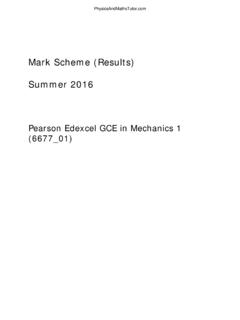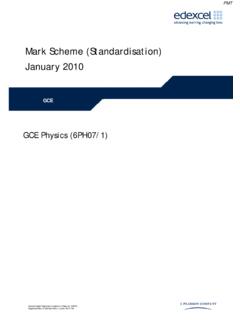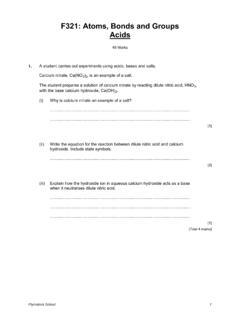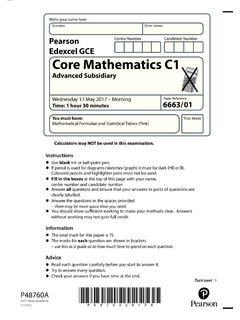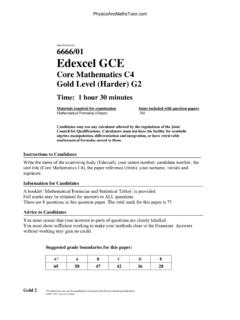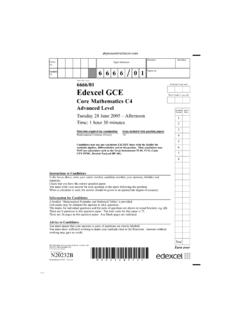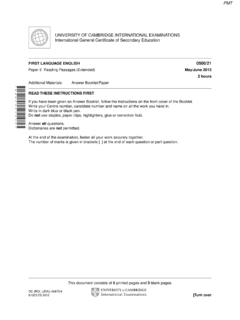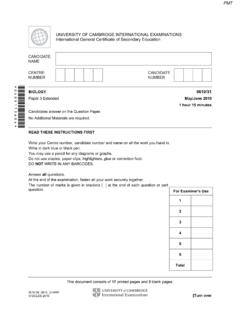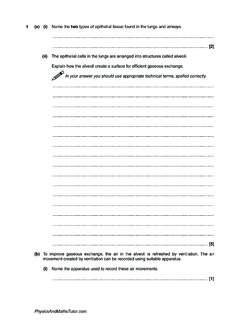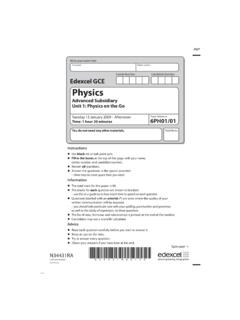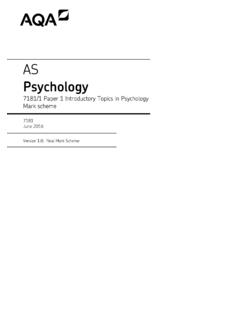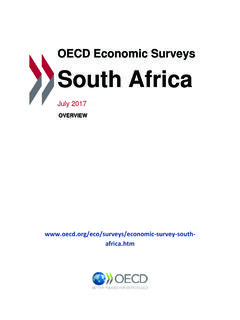Transcription of GEOGRAPHY 0460/12 May/June 2016 - Physics & Maths Tutor
1 PMT. Cambridge International Examinations Cambridge International General Certificate of Secondary Education GEOGRAPHY 0460/12 . Paper 1 May/June 2016 . mark scheme . Maximum Mark: 75. Published This mark scheme is published as an aid to teachers and candidates, to indicate the requirements of the examination. It shows the basis on which Examiners were instructed to award marks . It does not indicate the details of the discussions that took place at an Examiners' meeting before marking began, which would have considered the acceptability of alternative answers. Mark schemes should be read in conjunction with the question paper and the Principal Examiner Report for Teachers. Cambridge will not enter into discussions about these mark schemes . Cambridge is publishing the mark schemes for the May/June 2016 series for most Cambridge IGCSE , Cambridge International A and AS Level components and some Cambridge O Level components. IGCSE is the registered trademark of Cambridge International Examinations.
2 This syllabus is approved for use in England, Wales and Northern Ireland as a Cambridge International Level 1/Level 2 Certificate. This document consists of 20 printed pages. UCLES 2016 [Turn over PMT. Page 2 mark scheme Syllabus Paper Cambridge IGCSE May/June 2016 0460 12. The features of the marking scheme Each question carries 25 marks . Candidates cannot earn above the maximum marks available within each sub section. The marking scheme attempts to give guidance about the requirements of each answer and lists a number of responses, which will earn marks along with the general principles to be applied when marking each question. It should be noted that candidates can earn marks if their answers are phrased differently provided they convey the same meaning as those in the mark scheme . THE CANDIDATES DO NOT NEED TO. USE THE SAME WORDING TO EARN marks . The notation etc.' at the end of an answer in the mark scheme signifies that there may well be other correct responses or examples that can be given credit.]
3 Providing the statement is true, relevant to the question asked and not repetition of a previous point made credit should be given. A point made within one sub section which is an answer to the question set in a different sub section should not be given credit as each sub section asks different questions which require independent answers. The mark scheme uses semi colons (;) to separate marks and diagonals to separate alternative answers. During coordination the mark scheme is modified to add points agreed after discussion or to delete any points not allowed. All examiners should ensure that their modified scheme is fully up to date before marking begins. Marking Mechanics. Point marking is used for sections (a) and (b) of each question, although marks are available in specified questions for development of appropriate points. Ticks should be used to clearly indicate where a mark has been allowed. Where a development point has been allowed the symbol DEV . should be placed adjacent to the tick.
4 The number of ticks should always be equal to the total number of marks awarded. Only one development mark for each mark scheme point please. Where a candidate makes a point which is not quite sufficient for credit an upturned `V` insert symbol should be used. If after careful consideration a mark is awarded which gives `benefit of doubt` to the candidate the letter `J` should be placed adjacent to the tick ( the candidate has `just` achieved the mark). Crosses are acceptable to signify wrong answers and the letters `I/R` should be used to indicate those which are irrelevant. Levels of response marking is used for section (c) of each question. Thus it is the quality of the response that determines which level an answer is achieved rather than the quantity of statements contained within it. However, once assigned to a level the mark achieved within that level is determined by the number of points made. Levels 1 and 2 are distinguished by whether statements are simple (level 1) or developed/elaborated (level 2).
5 A candidate can immediately enter L2 by making developed points without making any L1. statements. In order to achieve L3 a candidate must have already reached the top end of L2 in addition his/her answer should have a clear example and if the answer is place specific as well (7. marks ). Highlight place specific detail. Cambridge International Examinations 2016 . PMT. Page 3 mark scheme Syllabus Paper Cambridge IGCSE May/June 2016 0460 12. Where statements are assigned levels by the examiner this should be indicated by the use of L1 and L2 next to the statements. Ticks should not be used on answers that are marked using levels of response marking. L1 annotation should be removed once a L2 is awarded for an answer. L3. annotation is not used. There is no need for a summary level at the end of a response. Summary: Level 1 (1 to 3 marks ): 1 simple statement (1 mark). 2 simple statements (2 marks ). 3 simple statements (3 marks ). Level 2 (4 to 6 marks ): 1 developed statement (4 marks ). 2 developed statements (5 marks ).
6 3 or more developed statements with eg (6 marks ). Level 3 (7 marks ). 3 or more developed statements + named example with at least one piece of place specific detail. Cambridge International Examinations 2016 . PMT. Page 4 mark scheme Syllabus Paper Cambridge IGCSE May/June 2016 0460 12. 1 (a) (i) out of 1000 people die per year or in 2013 of the population died in 2013. [1]. NB: South Africa is not needed. Look for as an exact figure. (ii) Vietnam [2]. Kuwait 2 @ 1 mark (2). (iii) Ideas such as (variations in amount/quality of): [3]. health care/hospital/clinics/medicines;. number of people per doctor/availability of doctors;. food supply/diet/famine/starvation;. water supply/quality/drought;. sanitation/hygiene;. diseases or examples/AIDS or HIV;. wars;. vaccinations;. education about healthcare/disease;. care for the elderly/pensions etc 3 @ 1 mark (3). (b) (i) Steep reduction from 1960 to 2000; [3]. levels off after 2000. or Look at the four time periods on the graph and accept any two statements with appropriate dates.
7 Steep reduction Period 1. gentle reduction Period 2. steep decline Period 3. levels off Period 4. MAX 1 for at least 2 supporting statistics (eg 47 in 1960, 17 in 2000). Can accept a figure for the change with two supporting dates. NB: Reserve 1 mark for statistics. Do not need per 1000. Accept tolerance on statistics . plus or minus one either way. We are not looking for candidates to describe the overall trend (1960 2015). However, statistics for these years would be fine. 3 @ 1 mark (3). Cambridge International Examinations 2016 . PMT. Page 5 mark scheme Syllabus Paper Cambridge IGCSE May/June 2016 0460 12. (ii) Ideas such as: [4]. government restricted family size/number of children by the use of 2 child limit;. people fined/ had land taken off them/lost income if they did not follow the policy;. incentives such as education for two children only;. contraception/abortions made available or made cheaper;. campaigns for people to use contraception/abortions;. people concentrating on careers.
8 Education of women;. education about family planning;. later marriages;. improvement of infant healthcare/lower IMR;. pensions;. mechanisation of farms/less agricultural work/more emphasis on secondary and tertiary sector etc. 4 @ 1 mark (4). (iii) Ideas such as: [5]. they have fallen below replacement level/population decline/death rates higher than birth rates;. shortage of workers/shortage of working class/less economically active/no one to care for the elderly/people to exploit the resources;. low level of production/businesses fail;. difficult to defend country;. ageing population/increase in elderly people/lots of old dependents;. lack of innovation;. closure of schools/nurseries;. need to raise more taxes/less tax payers/burden on economically active;. need to pay more pensions/provide more care homes/healthcare for the elderly;. economic decline/reduces the economy;. need to encourage migration etc. 5 @ 1 mark or development (5). Cambridge International Examinations 2016 . PMT.
9 Page 6 mark scheme Syllabus Paper Cambridge IGCSE May/June 2016 0460 12. (c) Levels marking [7]. Please ensure that you refer to the marking mechanics section at the front of the mark scheme before marking the level questions. NB: Statistics can be used as development to a maximum of 1 L2 4 marks . This applies to all levels marked questions. Level 1 [1 3 marks ]. Statements including limited detail which describe the problems caused by over population. Level 2 [4 6 marks ]. Uses named example. More developed statements which describe the problems caused by over population. (NB Max 5 if no named or inappropriate example). Level 3 [7 marks ]. Uses named example. Comprehensive and accurate statements including some place specific reference. Content Guide: Answers are likely to refer to: not enough housing water and air pollution shortage of food and water high crime rates not enough health care and education lack of employment poverty etc Place specific reference is likely to consist of: Named parts of the chosen country/locational detail, Population data/statistics NB: Development is of the problem not the causes.
10 The focus is on impacts within the country. [TOTAL 25 marks ]. Cambridge International Examinations 2016 . PMT. Page 7 mark scheme Syllabus Paper Cambridge IGCSE May/June 2016 0460 12. 2 (a) (i) A settlement in the countryside/small settlement/a settlement surrounded by fields/a settlement consisting of only a few houses. [1]. 1 mark (1). (ii) Ideas such as both; [2]. are linear/have developed along a road;. are aligned from north south;. are small/about 400 metres long/around 13 16 buildings/only a few buildings in them;. both have large and small buildings;. both surrounded by fields etc. 2 @ 1 mark (2). (iii) Ideas such as: [3]. separated by countryside/farmland/woodland/by fields;. buildings are scattered/separated from each/in small groups/far apart/spread out;. no focus/central part of settlement/no roads meet in the middle;. no/few services available;. low population density/sparsely populated etc. 3 @ 1 mark (3). (iv) Ideas such as: [4]. roads from all directions meet/nodal point/crossroads.
